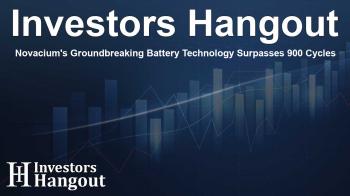Novacium's Groundbreaking Battery Technology Surpasses 900 Cycles

Introduction to Novacium's Advancements
Recently, the impressive achievements of Novacium's silicon-anode batteries have made headlines in the technology sector. These innovative batteries have demonstrated remarkable performance capabilities, achieving over 900 charging cycles with a sustained efficiency that surpasses traditional 18650 cells. This milestone reinforces Novacium's position as a leader in battery technology, particularly with their focus on energy efficiency and performance.
Exceptional Test Results
Novacium's latest testing results have provided compelling evidence of the superior qualities of their GEN3 silicon-anode batteries. During extensive evaluations, these batteries exhibited:
- High Capacity and Durability: GEN3 silicon-anode batteries showcased exceptional capacity retention, maintaining more than 80% of their initial capacity even after 900 cycles.
- Outperforming Traditional Cells: Compared to conventional commercial 18650 batteries, Novacium's cells demonstrated markedly higher performance.
- Average Coulombic Efficiency: These batteries achieved an impressive average Coulombic efficiency of 99.88%, setting a new standard in battery technology.
- Cumulative Energy Gain: The silicon-anode batteries illustrated a cumulative energy gain of over 31% compared to their graphite counterparts.
Understanding the Performance Metrics
At 900 cycles, the GEN3 18650 batteries effectively managed to deliver more than 3,100 milliampere-hours (mAh) of capacity. This is a significant achievement when analyzed against traditional graphite benchmark batteries, which typically show a diminishing return on capacity and energy output.
The carried-out analysis also indicated that the traditional graphite benchmark batteries yielded about 2,400 Ampere-Hours (Ah) while Novacium's GEN3 batteries produced around 3,200 Ah, reflecting a substantial energy efficiency leap of over 30%.
Comments from Leadership
Dr. Jed Kraiem, COO of Novacium, remarked, "These promising results confirm our unique capabilities in producing advanced silicon-based materials. They integrate seamlessly with existing battery manufacturing processes, thanks to our refined techniques. Continuous innovations will likely unlock even greater performance and longevity in future production cycles."
Competitive Edge in the Battery Market
What makes Novacium's batteries an exciting option for industries relying on high-capacity energy solutions is not only their performance but also their potential to innovate further. The battery market is rapidly evolving, and Novacium’s research into silicon-based anodes indicates a progressive direction toward sustainability and efficiency.
Integrating into Existing Manufacturing
With the rise in demand for energy-efficient materials, Novacium's silicon-anode technology possesses the potential to capture significant market share. It could replace up to 10% of traditional graphite anode materials without requiring extensive adjustments to existing manufacturing processes.
Future Developments and Market Trends
The commitment to enhancing silicon-anode technology aligns with the broader market trends anticipated in the energy storage sector. Market assessments predict that the lithium-ion battery market will expand significantly, with a corresponding increase in the usage rates of silicon in anodes due to its high capacity and efficiency. Analysts expect the global silicon-based materials market to draw significant interest as demand for energy storage solutions rises, particularly in the sectors of electric vehicles and consumer electronics.
Frequently Asked Questions
What are the key benefits of Novacium's GEN3 silicon-anode batteries?
The GEN3 batteries provide excellent capacity retention, extremely high Coulombic efficiency, and outperform traditional graphite-based batteries in terms of energy gains and durability.
How many cycles can Novacium's batteries endure?
Novacium's silicon-anode batteries have shown results exceeding 900 cycles, retaining over 80% of their initial capacity, which is impressive compared to traditional options.
What industries could benefit from Novacium's battery technology?
Industries relying on high-performance energy storage, such as electric vehicles, renewable energy systems, and consumer electronics, stand to benefit significantly from this technology.
What is the expected market trend for silicon-based anodes?
As energy storage demand grows, the market for silicon-based anodes is projected to expand, potentially capturing a large share of the graphite market within the next few years.
Who leads Novacium and what is their vision?
Dr. Jed Kraiem and a team of esteemed researchers lead Novacium, focusing on developing sustainable solutions and enhancing the energy capacity offered by silicon-based technology.
About The Author
Contact Logan Wright privately here. Or send an email with ATTN: Logan Wright as the subject to contact@investorshangout.com.
About Investors Hangout
Investors Hangout is a leading online stock forum for financial discussion and learning, offering a wide range of free tools and resources. It draws in traders of all levels, who exchange market knowledge, investigate trading tactics, and keep an eye on industry developments in real time. Featuring financial articles, stock message boards, quotes, charts, company profiles, and live news updates. Through cooperative learning and a wealth of informational resources, it helps users from novices creating their first portfolios to experts honing their techniques. Join Investors Hangout today: https://investorshangout.com/
The content of this article is based on factual, publicly available information and does not represent legal, financial, or investment advice. Investors Hangout does not offer financial advice, and the author is not a licensed financial advisor. Consult a qualified advisor before making any financial or investment decisions based on this article. This article should not be considered advice to purchase, sell, or hold any securities or other investments. If any of the material provided here is inaccurate, please contact us for corrections.

